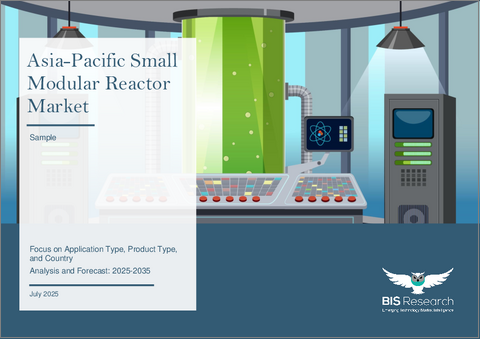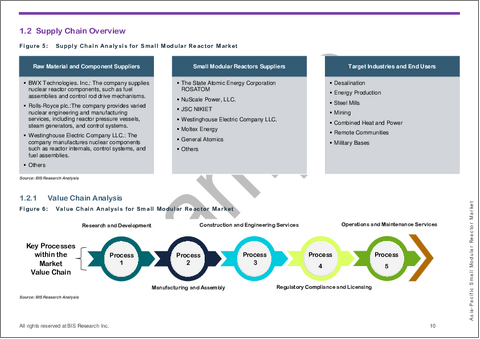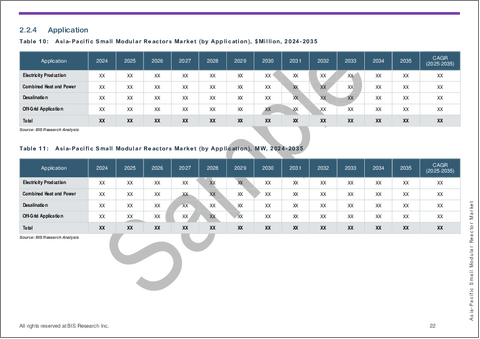|
|
市場調査レポート
商品コード
1781120
アジア太平洋地域の小型モジュール炉市場:用途・製品タイプ・国別の分析・予測 (2025-2035年)Asia-Pacific Small Modular Reactor Market: Focus on Application Type, Product Type, and Country - Analysis and Forecast, 2025-2035 |
||||||
カスタマイズ可能
|
|||||||
| アジア太平洋地域の小型モジュール炉市場:用途・製品タイプ・国別の分析・予測 (2025-2035年) |
|
出版日: 2025年07月31日
発行: BIS Research
ページ情報: 英文 61 Pages
納期: 1~5営業日
|
全表示
- 概要
- 図表
- 目次
アジア太平洋地域の小型モジュール炉の市場規模は、2024年の1億10万米ドルから、予測期間中はCAGR 14.15%で推移し、2035年には3億5,830万米ドルに成長すると予測されています。
アジア太平洋地域では、工場ベースの製造、標準化された設計、柔軟な配備が可能なモジュール型原子炉技術の採用が進んでおり、市場が拡大しています。各国がエネルギー源の多様化と炭素排出の削減を目指す中で、小型モジュール炉 (SMR) は、遠隔地や工業地帯への電力供給、老朽化した送電網の補完手段として注目を集めています。また、エネルギー安全保障の確保、迅速な導入スケジュール、安全性能の向上といった点が、需要のさらなる後押しとなっています。世界がよりクリーンで強靭なエネルギー源へと移行する中で、同地域は、原子炉設計、デジタル制御システム、高効率製造技術の進歩により、SMR研究の主要拠点として台頭しています。
| 主要市場統計 | |
|---|---|
| 予測期間 | 2025-2035年 |
| 2025年評価 | 9,540万米ドル |
| 2035年予測 | 3億5,830万米ドル |
| CAGR | 14.15% |
アジア太平洋地域のSMR市場は急速に拡大しており、同地域の長期的なエネルギー戦略において不可欠な存在となりつつあります。SMRは、エネルギー消費の増加、脱炭素化目標、遠隔地や工業地域におけるエネルギー供給の必要性に対応する柔軟な手段を提供します。クリーンで信頼性が高く、スケーラブルな電力への需要の高まりが、こうした動きを後押ししています。SMRは、工場での製造、モジュール設計、迅速な導入が可能であることから、急成長を遂げているアジア太平洋地域の経済にとって非常に魅力的です。
中国、インド、日本、韓国といった国々は、政府の強力な支援、官民連携、原子力研究開発への投資を背景に、SMR開発の最前線を走っています。海水淡水化や電力網の安定化から、水素製造や重工業向けのプロセス熱供給まで、SMRの応用範囲は広く検討されています。
アジア太平洋地域は地理的条件やエネルギー需要が多様であるため、大規模な原子力発電所の設置が難しい場所では、SMRが戦略的に適しているとされています。また、カーボンニュートラルやエネルギーの多様化、化石燃料への依存低減への関心の高まりが、地域のSMRへの関心をさらに加速させています。今後、先進的な原子炉設計やデジタル技術の進展に伴い、同地域のSMR市場は力強い成長を遂げ、この地域におけるよりクリーンで強靭なエネルギーの未来を形作る上で、重要な役割を果たすと見込まれています。
市場の分類:
セグメンテーション1:用途別
- 発電
- 熱電併給 (CHP)
- 海水淡水化
- オフグリッド用途
セグメンテーション2:原子炉タイプ別
- 水冷式原子炉
- 液体金属冷却高速中性子スペクトル炉
- 溶融塩炉
- 高温ガス冷却炉
セグメンテーション3:発電容量別
- 25 mw未満
- 25-100 mw
- 101-300 mw
- 300 mw超
セグメンテーション4:地域別
- 中国、日本
当レポートでは、アジア太平洋地域の小型モジュール炉の市場を調査し、主要動向、市場影響因子の分析、法規制環境、技術・特許の分析、市場規模の推移・予測、各種区分・地域/主要国別の詳細分析、競合情勢、主要企業のプロファイルなどをまとめています。
目次
エグゼクティブサマリー
範囲と定義
第1章 市場
- 動向:現状と将来への影響評価
- クリーンエネルギーソリューションへの関心の高まり
- 規制と政策支援
- サプライチェーンの概要
- バリューチェーン分析
- 研究開発レビュー
- 特許出願動向 (年別・特許庁別の特許件数)
- 規制状況
- SMRの経済前提のサマリー
- SMR設計の推定CAPEXおよびOPEXコンポーネントコスト
- 市場力学の概要
- 市場促進要因
- 市場抑制要因
- 市場機会
第2章 地域
- 地域サマリー
- アジア太平洋
- 地域概要
- 市場成長の原動力
- 市場課題
- 用途
- 製品
- アジア太平洋 (国別)
第3章 市場:競合ベンチマーキングと企業プロファイル
- 次のフロンティア
- 市場シェアと戦略的取り組み
- 企業プロファイル
- Tsinghua University
- Japan Atomic Energy Agency
- China National Nuclear Corporation
- State Power Investment Corporation Limited
- MITSUBISHI HEAVY INDUSTRIES, LTD.
第4章 調査手法
List of Figures
- Figure 1: Asia-Pacific Small Modular Reactor Market (by Scenario), $Million, 2025, 2029, and 2035
- Figure 2: Asia-Pacific Small Modular Reactor Market, 2025-2035
- Figure 3: Market Snapshot, 2024
- Figure 4: Small Modular Reactor Market, $Million, 2024 and 2035
- Figure 5: Asia-Pacific Small Modular Reactor Market (by Application), $Million, 2024, 2029, and 2035
- Figure 6: Asia-Pacific Small Modular Reactor Market (by Reactor Type), $Million, 2024, 2029, and 2035
- Figure 7: Asia-Pacific Small Modular Reactor Market (by Power Generation Capacity), $Million, 2024, 2029, and 2035
- Figure 8: Supply Chain Analysis for Small Modular Reactor Market
- Figure 9: Value Chain Analysis for Small Modular Reactor Market
- Figure 10: Patent Analysis (by Year and Patent Office), January 2022-June 2025
- Figure 11: Impact Analysis of Market Navigating Factors, 2024-2035
- Figure 12: China Small Modular Reactors Market, $Million, 2024-2035
- Figure 13: Japan Small Modular Reactors Market, $Million, 2024-2035
- Figure 14: Strategic Initiatives, January 2022-June 2025
- Figure 15: Data Triangulation
- Figure 16: Top-Down and Bottom-Up Approach
- Figure 17: Assumptions and Limitations
List of Tables
- Table 1: Market Snapshot
- Table 2: Competitive Landscape Snapshot
- Table 3: Trends Overview
- Table 4: Regulatory Landscape of Small Modular Reactor Market
- Table 5: Summary of Economic Assumptions for SMRs in Terms of FOAK and NOAK
- Table 6: CAPEX Component Costs for Selected SMR Designs ($/kW)
- Table 7: OPEX Component Costs for Selected SMR Designs ($/kW)
- Table 8: Small Modular Reactors Market (by Region), $Million, 2024-2035
- Table 9: Small Modular Reactors Market (by Region), MW, 2024-2035
- Table 10: Asia-Pacific Small Modular Reactors Market (by Application), $Million, 2024-2035
- Table 11: Asia-Pacific Small Modular Reactors Market (by Application), MW, 2024-2035
- Table 12: Asia-Pacific Small Modular Reactors Market (by Reactor Type), $Million, 2024-2035
- Table 13: Asia-Pacific Small Modular Reactors Market (by Reactor Type), MW, 2024-2035
- Table 14: Asia-Pacific Small Modular Reactors Market (by Power Generation Capacity), $Million, 2024-2035
- Table 15: Asia-Pacific Small Modular Reactors Market (by Power Generation Capacity), MW, 2024-2035
- Table 16: China Small Modular Reactors Market (by Application), $Million, 2024-2035
- Table 17: China Small Modular Reactors Market (by Application), $Million, 2024-2035
- Table 18: China Small Modular Reactors Market (by Reactor Type), $Million, 2024-2035
- Table 19: China Small Modular Reactors Market (by Reactor Type), MW, 2024-2035
- Table 20: China Small Modular Reactors Market (by Power Generation Capacity), $Million, 2024-2035
- Table 21: China Small Modular Reactors Market (by Power Generation Capacity), MW, 2024-2035
- Table 22: Japan Small Modular Reactors Market (by Application), $Million, 2024-2035
- Table 23: Japan Small Modular Reactors Market (by Application), $Million, 2024-2035
- Table 24: Japan Small Modular Reactors Market (by Reactor Type), $Million, 2024-2035
- Table 25: Japan Small Modular Reactors Market (by Reactor Type), MW, 2024-2035
- Table 26: Japan Small Modular Reactors Market (by Power Generation Capacity), $Million, 2024-2035
- Table 27: Japan Small Modular Reactors Market (by Power Generation Capacity), MW, 2024-2035
- Table 28: Market Share, 2023
This report can be delivered in 2 working days.
Introduction to Asia-Pacific Small Modular Reactor Market
The Asia-Pacific small modular reactor market was valued at $100.1 million in 2024 and is projected to grow at a CAGR of 14.15%, reaching $358.3 million by 2035. The market is expanding in the APAC area due to the growing use of modular nuclear reactor technologies, which have factory-based manufacturing, standardized designs, and flexible deployment. As countries attempt to diversify energy sources and minimize carbon emissions, Small Modular Reactors (SMRs) are gaining popularity for powering distant locations, industrial zones, and supplementing aging grid systems. Demand is also being driven by the region's emphasis on energy security, quicker deployment schedules, and enhanced safety performance. As the world moves toward cleaner, more robust energy sources, APAC is emerging as a major center for SMR research thanks to technological developments in reactor designs, digital control systems, and efficient manufacturing.
| KEY MARKET STATISTICS | |
|---|---|
| Forecast Period | 2025 - 2035 |
| 2025 Evaluation | $95.4 Million |
| 2035 Forecast | $358.3 Million |
| CAGR | 14.15% |
Market Introduction
The market for small modular reactors (SMRs) in Asia-Pacific (APAC) is expanding quickly and is becoming an essential part of the region's long-term energy strategy. SMRs provide a versatile way to meet increasing energy consumption, decarbonization goals, and the requirement for energy availability in distant and industrial areas. This is driven by the growing demand for clean, dependable, and scalable electricity. They are particularly appealing to APAC's rapidly rising economies due to their factory-based manufacture, modular design, and quicker deployment schedules.
With the help of robust government support, public-private collaborations, and investments in nuclear research and development, nations like China, India, Japan, and South Korea are leading the way in SMR development. Applications for SMRs are being investigated for anything from desalination and grid stability to the production of hydrogen and process heat for heavy industries.
The APAC region's diverse geography and energy needs make SMRs a strategic fit, particularly where large-scale nuclear plants are not feasible. Additionally, heightened focus on carbon neutrality, energy diversification, and minimizing dependency on fossil fuels is accelerating regional interest. As advancements in advanced reactor designs and digital technologies continue, the APAC SMR market is expected to experience strong growth and play a key role in shaping a cleaner, more resilient energy future for the region.
Market Segmentation
Segmentation 1: by Application
- Electricity Production
- Combined Heat and Power
- Desalination
- Off-grid application
Segmentation 2: by Reactor Type
- Water-Cooled Reactors
- Liquid Metal-Cooled Fast Neutron Spectrum Reactors
- Molten Salt Reactors
- High-Temperature Gas-Cooled Reactors
Segmentation 3: by Power Generation Capacity
- <25 MW
- 25-100 MW
- 101-300 MW
- >300 MW
Segmentation 4: by Region
- Asia-Pacific - China, Japan
APAC Small Modular Reactor Market Trends, Drivers and Challenges
Key Market Trends
- Rising interest in decentralized and off-grid nuclear power solutions across remote regions and island nations.
- Increasing government-backed R&D programs and public-private partnerships to accelerate SMR deployment.
- Growing focus on hybrid energy systems integrating SMRs with renewables (solar, wind) and hydrogen production.
- Shift toward factory-fabricated, transportable SMR modules for faster and cost-effective deployment.
- Advancements in Generation IV reactor technologies and passive safety systems.
Key Market Drivers
- Surging electricity demand in developing economies like India, Indonesia, and Vietnam.
- Need for clean, reliable baseload power to support decarbonization and energy security goals.
- Limited land availability and public resistance to large-scale nuclear plants favoring smaller, safer reactor options.
- Supportive policy frameworks, feasibility studies, and funding initiatives in countries such as China and South Korea.
- Industrial and remote site demand for compact, high-efficiency nuclear solutions.
Major Challenges
- High initial development and certification costs for SMR technologies.
- Complex and varying regulatory landscapes across APAC countries.
- Limited operational experience and demonstration projects compared to conventional reactors.
- Public perception concerns regarding nuclear safety and waste management.
- Supply chain limitations and dependency on international nuclear fuel and component vendors.
How can this report add value to an organization?
Product/Innovation Strategy: The APAC small modular reactor market has been segmented based on application, reactor type, power generation capacity, and end-user category, providing valuable insights into deployment strategies and technology preferences. Application segmentation includes electricity production, combined heat and power, desalination, and off-grid power. By reactor type, the market has been divided into water-cooled reactors, liquid metal-cooled fast neutron spectrum reactors, molten salt reactors, and high-temperature gas-cooled reactors. Capacity segmentation covers units under 25 MW, 25-100 MW, 101-300 MW, and above 300 MW. The end user segmentation includes utilities, industrial operators, off-grid microgrid providers, and desalination plant operators. This segmentation framework supports targeted market analysis and strategic planning by stakeholders across technology development, policy, and finance.
Growth/Marketing Strategy: The APAC small modular reactor market has been growing at a rapid pace. The market offers enormous opportunities for existing and emerging market players. Some of the strategies covered in this segment are mergers and acquisitions, product launches, partnerships and collaborations, business expansions, and investments. The strategies preferred by companies to maintain and strengthen their market position primarily include product development.
Competitive Strategy: The key players in the APAC small modular reactor market analyzed and profiled in the study include professionals with expertise in the small modular reactor domain. Additionally, a comprehensive competitive landscape, such as partnerships, agreements, and collaborations, is expected to aid the reader in understanding the untapped revenue pockets in the market.
Key Market Players and Competition Synopsis
The companies that are profiled in the Asia-Pacific small modular reactor market have been selected based on inputs gathered from primary experts who have analyzed company coverage, product portfolio, and market penetration.
Some of the prominent names in this market are:
- Tsinghua University
- Japan Atomic Energy Agency
- China National Nuclear Corporation
- MITSUBISHI HEAVY INDUSTRIES, LTD.
Table of Contents
Executive Summary
Scope and Definition
1 Markets
- 1.1 Trends: Current and Future Impact Assessment
- 1.1.1 Growing Interest in Clean Energy Solutions
- 1.1.2 Regulatory and Policy Support
- 1.2 Supply Chain Overview
- 1.2.1 Value Chain Analysis
- 1.3 Research and Development Review
- 1.3.1 Patent Filing Trend (Number of Patents by Year and by Patent Office)
- 1.4 Regulatory Landscape
- 1.5 Summary of Economic Assumptions for SMRs
- 1.6 Estimated CAPEX and OPEX Component Costs for SMR Designs ($/kW)
- 1.7 Market Dynamics Overview
- 1.7.1 Market Drivers
- 1.7.1.1 Advancements in Nuclear Technology
- 1.7.1.2 Growing Research and Development Activities to Achieve Near Zero Emissions
- 1.7.2 Market Restraints
- 1.7.2.1 High Initial Costs and Infrastructure Limitations
- 1.7.2.2 Regulatory and Licensing Hurdles
- 1.7.3 Market Opportunities
- 1.7.3.1 Surge in Decarbonization Policies
- 1.7.3.2 Energy Access in Remote and Off-Grid Areas
- 1.7.1 Market Drivers
2 Regions
- 2.1 Regional Summary
- 2.2 Asia-Pacific
- 2.2.1 Regional Overview
- 2.2.2 Driving Factors for Market Growth
- 2.2.3 Factors Challenging the Market
- 2.2.4 Application
- 2.2.5 Product
- 2.2.6 Asia-Pacific (by Country)
- 2.2.6.1 China
- 2.2.6.1.1 Application
- 2.2.6.1.2 Product
- 2.2.6.2 Japan
- 2.2.6.2.1 Application
- 2.2.6.2.2 Product
- 2.2.6.1 China
3 Markets - Competitive Benchmarking and Company Profiles
- 3.1 Next Frontiers
- 3.2 Market Share and Strategic Initiatives
- 3.3 Company Profiles
- 3.3.1 Tsinghua University
- 3.3.1.1 Overview
- 3.3.1.2 Top Products/Product Portfolio
- 3.3.1.3 Top Competitors
- 3.3.1.4 Target Customers/End Users
- 3.3.1.5 Key Personnel
- 3.3.1.6 Analyst View
- 3.3.2 Japan Atomic Energy Agency
- 3.3.2.1 Overview
- 3.3.2.2 Top Products/Product Portfolio
- 3.3.2.3 Top Competitors
- 3.3.2.4 Target Customers/End Users
- 3.3.2.5 Key Personnel
- 3.3.2.6 Analyst View
- 3.3.3 China National Nuclear Corporation
- 3.3.3.1 Overview
- 3.3.3.2 Top Products/Product Portfolio
- 3.3.3.3 Top Competitors
- 3.3.3.4 Target Customers/End Users
- 3.3.3.5 Key Personnel
- 3.3.3.6 Analyst View
- 3.3.4 State Power Investment Corporation Limited
- 3.3.4.1 Overview
- 3.3.4.2 Top Products/Product Portfolio
- 3.3.4.3 Top Competitors
- 3.3.4.4 Target Customers/End Users
- 3.3.4.5 Key Personnel
- 3.3.4.6 Analyst View
- 3.3.5 MITSUBISHI HEAVY INDUSTRIES, LTD.
- 3.3.5.1 Overview
- 3.3.5.2 Top Products/Product Portfolio
- 3.3.5.3 Top Competitors
- 3.3.5.4 Target Customers/End Users
- 3.3.5.5 Key Personnel
- 3.3.5.6 Analyst View
- 3.3.1 Tsinghua University
4 Research Methodology
- 4.1 Data Sources
- 4.1.1 Primary Data Sources
- 4.1.2 Secondary Data Sources
- 4.1.3 Data Triangulation
- 4.2 Market Estimation and Forecast





